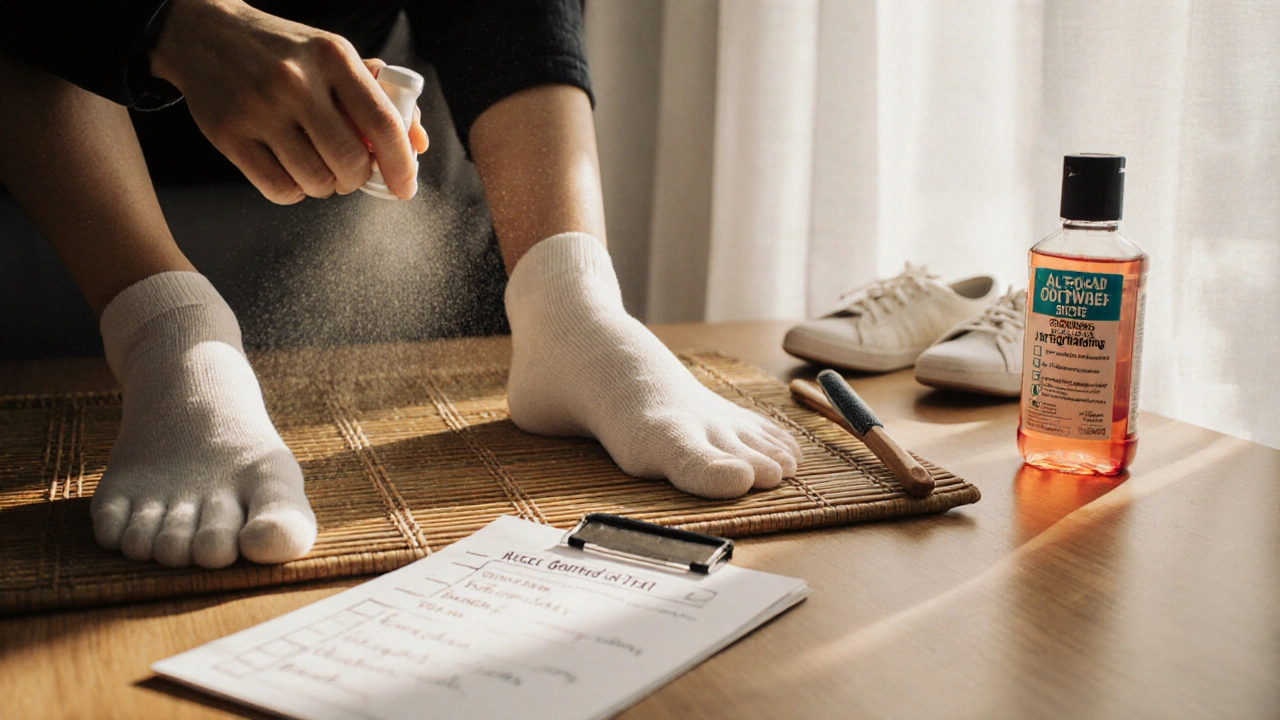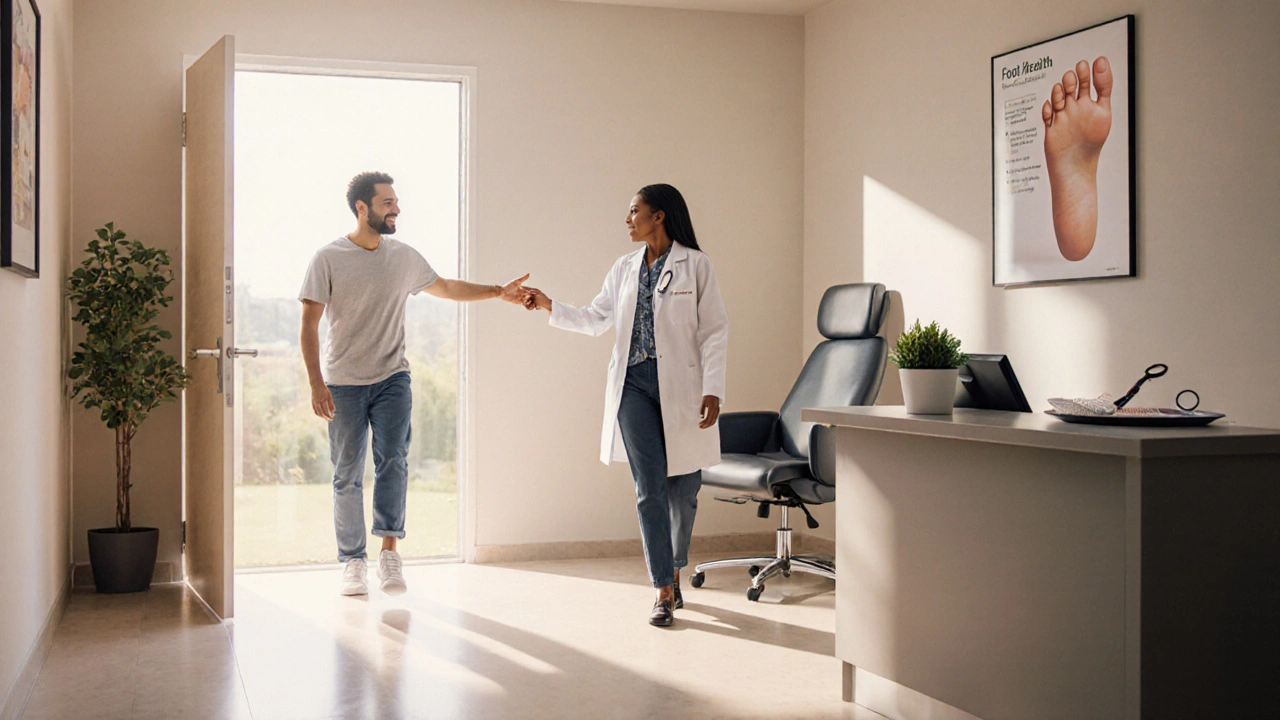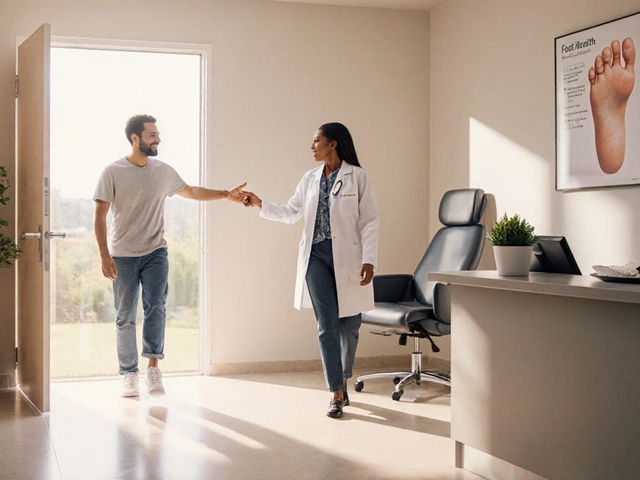Fungal Infection Risk Assessment Tool
Personalized Risk Assessment
Answer these questions to determine your recommended fungal infection screening frequency.
Your Results
Risk Level
Risk Factors Identified
Key Symptoms to Monitor
Imagine walking into a doctor's office for a routine fungal infection check-up and discovering a problem before it becomes a painful, costly nightmare. Regular health screening can spot hidden fungal threats early, keeping you healthy and saving you time, money, and discomfort.
What a Fungal Infection Really Is
Fungal infection is a medical condition where fungi invade skin, nails, lungs or internal organs, causing a range of symptoms from mild itching to severe organ damage. The most common culprits are dermatophytes - the fungi that cause athlete’s foot, ringworm and nail infections. Candida species often hide in warm, moist areas and can trigger oral thrush or vaginal yeast infections. Inhaled spores from Aspergillus may settle in the lungs, especially in people with weakened immune systems.
Why Early Detection Saves You From Trouble
Fungi multiply quickly. Left unchecked, a tiny skin rash can spread to nails, or a mild oral thrush can become a systemic infection that attacks the bloodstream. Early detection means treatment can start when antifungal medication is most effective and side‑effects are minimal.
People who are immunocompromised - such as those on chemotherapy, organ‑transplant recipients, or individuals with uncontrolled diabetes - face a dramatically higher risk. A seemingly harmless infection can turn life‑threatening within days. Spotting the issue during a routine visit gives clinicians a chance to act before the fungus spreads.

How Regular Check‑Ups Catch Hidden Fungi
During a standard appointment, clinicians look for visual signs and may order simple tests. The most common tools are:
- Skin scraping - a tiny sample taken from the affected area and examined under a microscope.
- Lab culture - the sample is placed on a nutrient medium to let the fungus grow, revealing its species after 2-7 days.
- PCR test - a rapid molecular method that detects fungal DNA, delivering results within hours.
These tests are painless, inexpensive, and can be performed in most primary‑care settings. When a clinician spots an early rash or nail change, they’ll often request one of these investigations right away.
How Often Should You Schedule a Fungal Infection Check‑Up?
For most healthy adults, an annual health review is enough. However, certain groups need more frequent monitoring:
- Individuals with diabetes - every 6months.
- People on long‑term steroids or immunosuppressive drugs - every 3-4months.
- Athletes, hikers, or anyone regularly using communal showers or pools - twice a year.
When you book an appointment, tell the receptionist about any recent skin injuries, persistent itching, or changes in nail colour. That information helps the clinician prioritize fungal screening during the visit.
Red‑Flag Symptoms That Warrant an Immediate Visit
Even if you’re not on a strict screening schedule, these signs should trigger a same‑day appointment:
- Itchy, red patches that spread rapidly or form a ring‑shaped border (classic ringworm).
- Thick, discoloured nails that crumble or emit a foul smell.
- White patches on the tongue, inside the mouth, or a persistent cotton‑like feeling.
- Vaginal discharge that is thick, white, and accompanied by itching.
- Persistent cough, fever, or shortness of breath in a person with a compromised immune system - could signal inhaled fungal spores.
Early medical attention can prevent the infection from moving deeper into tissue or spreading to other body parts.

Simple Lifestyle Tweaks to Lower Your Risk
Regular visits are only part of the picture. You can actively keep fungi at bay with everyday habits:
- Keep feet dry - change socks after sweaty activities and use breathable shoes.
- Avoid sharing towels, razors, or nail clippers.
- Choose antifungal powders or sprays for athletes who train in humid environments.
- Maintain good oral hygiene; rinse with an alcohol‑free mouthwash if you’ve recently taken antibiotics.
- Control blood‑sugar levels if you have diabetes - high glucose feeds Candida.
When you combine these habits with routine check‑ups, you create a two‑layer defense that catches problems before they flare.
Quick Checklist for Your Next Appointment
- Note any recent skin changes, nail discoloration, or persistent itching.
- Write down medications, especially steroids, antibiotics, or chemotherapy agents.
- Bring a list of chronic conditions (diabetes, HIV, etc.).
- Ask the clinician about antifungal medication options if a test comes back positive.
- Schedule the next routine screening based on your risk profile.
Having this short list ready makes the visit smoother and ensures nothing gets missed.
Frequently Asked Questions
How long does a fungal culture take?
Most cultures grow visible colonies within 2‑7days. Some slow‑growing species may need up to two weeks, but the lab will notify you if additional time is required.
Are over‑the‑counter antifungals enough for early infections?
For mild skin rashes, topical creams like clotrimazole work well. However, a confirmed diagnosis ensures you use the most effective agent and avoids unnecessary drug exposure.
Can a negative skin scraping still mean I have a fungal infection?
Yes. Early lesions may contain few organisms, leading to a false‑negative result. In such cases, a repeat test or a more sensitive PCR assay is recommended.
What is the best way to protect my nails from fungal invasion?
Keep nails trimmed, dry, and avoid tight shoes. If you notice white spots or a thickened nail, book a check‑up promptly - early treatment can restore nail health.
Do regular check‑ups increase the risk of antibiotic resistance?
No. Screening focuses on detecting fungi, not prescribing antibiotics. When a fungal infection is identified, clinicians prescribe targeted antifungals rather than broad‑spectrum antibiotics.


Life is a series of hidden battles, and many of those wars are fought on the skin's surface.
Fungi, though microscopic, wage silent sieges that often go unnoticed until they breach our defenses.
When we schedule regular check‑ups, we essentially send scouts ahead, catching the invader before it builds a fortress.
Think of it as a routine patrol, a habit that transforms uncertainty into early awareness.
These inspections empower clinicians to pinpoint the subtle discoloration of a nail or the faint itch of a rash before it escalates.
Early detection also means we can choose the most targeted antifungal agents, sparing the body from harsher, broad‑spectrum treatments.
For athletes and hikers, the stakes are higher because communal spaces serve as fertile breeding grounds for spores.
Even a seemingly trivial foot odor can hint at a burgeoning athlete’s foot infection, ready to spread beyond the toes.
Patients with diabetes or on immunosuppressive therapy should especially heed the warning signs, as their immune armor is already compromised.
Regular lab work, skin scrapings, or even a quick PCR swab can reveal hidden pathogens that would otherwise lie dormant.
Think of it as a preventive vaccine of sorts, not against viruses, but against the fungal colonizers that love warm, moist environments.
When you bring these subtle clues to a doctor’s attention, you also give them a chance to educate you on lifestyle tweaks, like keeping feet dry or avoiding shared towels.
The cost of a routine visit pales in comparison to the expense of treating a systemic fungal infection that could end up in the bloodstream.
Moreover, early treatment reduces the risk of drug resistance developing, preserving our therapeutic arsenal for the future.
In short, regular check‑ups are the unsung heroes of health, turning potential crises into manageable footnotes in our medical history.
So, next time you book a physical, remember to ask about fungal screening – your future self will thank you. 😊
Just a heads up, if you’re someone who spends a lot of time in gyms or on the trail, getting a quick skin check every six months can save you a lot of hassle later. It’s an easy way to catch things early, especially if you notice any itching or nail changes. Keeping an eye on these signs and mentioning them at your appointment is all it takes. Stay chill and stay healthy.
🔬 The pathophysiology of dermatophyte colonization involves keratinase activation, which leads to progressive stratum corneum degradation. 📈 Early detection via KOH prep yields a sensitivity boost of approximately 85%, mitigating downstream inflammatory cascades. 🧪 PCR amplification of fungal rDNA offers rapid resolution, cutting diagnostic latency from days to hours. 😈 Yet, clinicians often underappreciate the subclinical mycotic load, which can act as a reservoir for opportunistic overgrowth. 😏 Integrating dermatoscopic imaging into routine exams enhances visual acuity, allowing for preemptive therapeutic intervention. 🛡️ For immunocompromised hosts, this preemptive stance translates into a tangible reduction in morbidity. 💊 Antifungal stewardship hinges on accurate early identification, preventing unnecessary polypharmacy. 📊 In practice, aligning patient-reported symptomatology with laboratory data creates a synergistic diagnostic algorithm. 📚 Bottom line: proactive screening is not just a recommendation-it’s a clinical imperative. 😊
Listen up, folks!!! Regular fungal check‑ups are a game‑changer!!! 🎯 You don’t have to wait for a rash to flare-schedule that appointment now and stay ahead of the curve!!! 🌟 A quick skin scrape or a simple swab can catch the sneaky fungus before it messes with your daily grind!!! 💪 If you’re training hard, you know how important it is to keep every part of your body in top shape-your feet are no exception!!! 🏃♂️ Remember, early detection means simpler treatment, less downtime, and more time crushing your goals!!! 🚀 So set a reminder, tell your doctor about any odd itchiness, and keep those fungal foes at bay!!! 🎉
Fellow Americans, our healthcare system thrives when we are proactive-regular fungal screenings are a patriotic duty!!! 🇺🇸 By catching infections early, we reduce the burden on our clinics and keep our communities strong!!! Precise diagnostics like PCR and culture are readily available across the nation, ensuring no one is left behind!!! 🏥 Let’s embrace these tools, share the knowledge, and protect our families from hidden fungal threats!!! Together, we stand resilient, healthy, and proud!!! 😊
Dear colleague, I concur with the observation regarding the significance of periodic examinations for individuals engaged in frequent athletic activities. It is indeed prudent to incorporate dermatological evaluations within the semi‑annual health review schedule. Moreover, the emphasis on early detection aligns with contemporary clinical guidelines, thereby mitigating the progression of opportunistic mycoses. Your counsel, albeit succinct, encapsulates the essence of preventive medicine. Respetfully, the author.
Hey there, great points about the science behind early detection! It can be overwhelming, but remember that a simple test can make a big difference. If you notice any itching or nail changes, don’t wait-let your doctor know next time you’re in for a visit. Stay positive and take care of yourself.
While the sentiment expressed is well‑intentioned, certain linguistic inaccuracies merit correction. The phrase “let your doctor know next time you’re in for a visit” should be rendered as “inform your physician during your upcoming appointment.” Additionally, “stay positive” would more precisely be “maintain a positive outlook.” Precision in language enhances clarity and professional communication.
I appreciate the philosophical depth of your discourse, yet I must highlight a minor grammatical oversight: the clause “your future self will thank you” should be preceded by a comma for proper punctuation. Nonetheless, the emotive resonance of your argument is undeniable, and it reinforces the urgency of early fungal screening. Thank you for the enlightening perspective.
Regular check‑ups save you money and pain. 😤